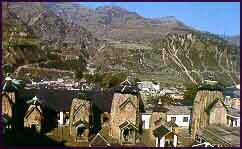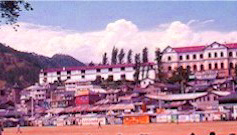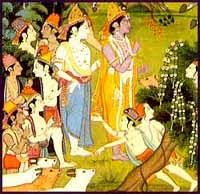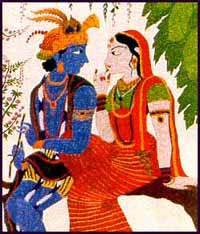Chamba is, in fact an entire district which includes in it's fold, the well-known mountain resort, Dalhousie. But we are now talking about Chamba proper. The kingdom of uninterrupted rule by a Rajput family from 550 AD till independence. The family has been traced to the first ruler Maru Verma who created his capital at nearby Bharmour, then called Brahmpura. It was near the 900's when Sahi Verma, a descendent, relocated the capital to Chamba. The name was drawn from his daughter's name Champavati. The remoteness of this Hindu kingdom protected it from Muslim invasion. So right in the midst of Muslim culture, a Hindu town lived and created within itself, fascinating temples. |
Chamba,in the north-west corner of Himachal Pradesh, is distinctive and unique in terms of geography, history and culture.
|
| | |
|

 If the location was unique, then sample these other aspects. The town seems very remote, even though it is just a little over 50 kms from Dalhousie. It seems inaccessible but it is at a mere altitude of 3,300 feet. Yet it is perched on a sort of shelf cut into the mountain and from its cliff, far below, the Ravi river goes by. In the distance, all around are panoramic snow views. This spectacular location, has prompted some to compare it to a medieval Italian village fortress. And bang in the centre along the cliff, is a large grassy 'chaugan' and above it, the Akhand Chandni palace of the erstwhile rulers. Today it houses a college and government offices.
If the location was unique, then sample these other aspects. The town seems very remote, even though it is just a little over 50 kms from Dalhousie. It seems inaccessible but it is at a mere altitude of 3,300 feet. Yet it is perched on a sort of shelf cut into the mountain and from its cliff, far below, the Ravi river goes by. In the distance, all around are panoramic snow views. This spectacular location, has prompted some to compare it to a medieval Italian village fortress. And bang in the centre along the cliff, is a large grassy 'chaugan' and above it, the Akhand Chandni palace of the erstwhile rulers. Today it houses a college and government offices.
The scenic charm of Chamba is but one story. Noteworthy, however are the carved ancient temples, considered by many, to be similar to those found in the desert state of Rajasthan. Most of them are clustered near the palace. While three temples are dedicated to Lord Vishnu, the other three are to Lord Shiva. All of them differ from other hill temples, with their shikaras or spires. The Lakshmi Narayan temple is the oldest of the lot. And all temples have been well preserved despite their really ancient origins.
 Besides these are some places that are well worth a visit. At the Chaugan, in the centre of the town, a fair happens every year and is the site of a Minjar procession. Lasting a week, it is a microcosm of the cultural life of Chamba. Another attraction is the Bhuri Singh museum, which has archived paintings and other artistic cultural heritage.
Besides these are some places that are well worth a visit. At the Chaugan, in the centre of the town, a fair happens every year and is the site of a Minjar procession. Lasting a week, it is a microcosm of the cultural life of Chamba. Another attraction is the Bhuri Singh museum, which has archived paintings and other artistic cultural heritage.

| History hasn't quite invaded the natural beauty of these hills, but has nevertheless made subtle impressions here and there.
|
| | |
|
A little way from the Chaugan is the Chamunda Devi temple overlooking the angry Ravi and the villages on the far bank. This place doubles up as a popular picnic spot. It is of course, the captivating landscape around Chamba that completes the picture. It all begins with a range of about 7,000 feet between the Pir Panjal and the Dhauladhar and a place called Salooni, 55 kms from Chamba. Salooni is a vantage point for some of the finest views in this kaleidoscopic topography. It stares into the picturesque Bhandal valley. This pleasant place links Chamba with Kashmir.
|
 A few kms by road and a few on foot, takes one to another pretty picnic spot called Sarol. Then of course there is the ancient capital of Bharmour, about 6,500 feet in altitude, with may more wonderful temples. Bharmour is also the trek off point for a challenging trek to the 14,000 feet high Mani Mahesh Lake.
A few kms by road and a few on foot, takes one to another pretty picnic spot called Sarol. Then of course there is the ancient capital of Bharmour, about 6,500 feet in altitude, with may more wonderful temples. Bharmour is also the trek off point for a challenging trek to the 14,000 feet high Mani Mahesh Lake.
And then that absolutely wild splendour of the Pangi valley, the one great ambition of many mountain lovers. But this mystery deserves its own special mention. Pangi cannot be merely part of a travel story on Chamba. It is another time span, another haven and another dream of the Himalayas. So, on Pangi ... another time.
 There in the northwest corner of Himachal, jutting into Kashmir, staking its very own peculiarity, in terms of geography, history and culture, is Chamba. Leaving the lonely pride of Dalhousie in the distance, by the Ravi river, still sandwiched between the Dhauladhar range and the Pir Panjal, Chamba is conspicuous by it's cross cultural mountain topography like a large nose ring on a Rajput woman's nose. A jewel and a unique one at that. Chamba is just in the right place.
There in the northwest corner of Himachal, jutting into Kashmir, staking its very own peculiarity, in terms of geography, history and culture, is Chamba. Leaving the lonely pride of Dalhousie in the distance, by the Ravi river, still sandwiched between the Dhauladhar range and the Pir Panjal, Chamba is conspicuous by it's cross cultural mountain topography like a large nose ring on a Rajput woman's nose. A jewel and a unique one at that. Chamba is just in the right place.

 If the location was unique, then sample these other aspects. The town seems very remote, even though it is just a little over 50 kms from Dalhousie. It seems inaccessible but it is at a mere altitude of 3,300 feet. Yet it is perched on a sort of shelf cut into the mountain and from its cliff, far below, the Ravi river goes by. In the distance, all around are panoramic snow views. This spectacular location, has prompted some to compare it to a medieval Italian village fortress. And bang in the centre along the cliff, is a large grassy 'chaugan' and above it, the Akhand Chandni palace of the erstwhile rulers. Today it houses a college and government offices.
If the location was unique, then sample these other aspects. The town seems very remote, even though it is just a little over 50 kms from Dalhousie. It seems inaccessible but it is at a mere altitude of 3,300 feet. Yet it is perched on a sort of shelf cut into the mountain and from its cliff, far below, the Ravi river goes by. In the distance, all around are panoramic snow views. This spectacular location, has prompted some to compare it to a medieval Italian village fortress. And bang in the centre along the cliff, is a large grassy 'chaugan' and above it, the Akhand Chandni palace of the erstwhile rulers. Today it houses a college and government offices.
 Besides these are some places that are well worth a visit. At the Chaugan, in the centre of the town, a fair happens every year and is the site of a Minjar procession. Lasting a week, it is a microcosm of the cultural life of Chamba. Another attraction is the Bhuri Singh museum, which has archived paintings and other artistic cultural heritage.
Besides these are some places that are well worth a visit. At the Chaugan, in the centre of the town, a fair happens every year and is the site of a Minjar procession. Lasting a week, it is a microcosm of the cultural life of Chamba. Another attraction is the Bhuri Singh museum, which has archived paintings and other artistic cultural heritage.
 A few kms by road and a few on foot, takes one to another pretty picnic spot called Sarol. Then of course there is the ancient capital of Bharmour, about 6,500 feet in altitude, with may more wonderful temples. Bharmour is also the trek off point for a challenging trek to the 14,000 feet high Mani Mahesh Lake.
A few kms by road and a few on foot, takes one to another pretty picnic spot called Sarol. Then of course there is the ancient capital of Bharmour, about 6,500 feet in altitude, with may more wonderful temples. Bharmour is also the trek off point for a challenging trek to the 14,000 feet high Mani Mahesh Lake.